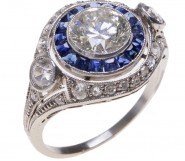Lot #6 - There are no known examples of this form in any public collection. There is a cup and saucer in the collection of the National Gallery of Australia. F
-
Auction House:Mossgreen
-
Sale Name:Clarendon House Auction
-
Sale Date:15 Apr 2012 ~ 11am (Lots 1 -241)
15 Apr 2012 ~ 2pm (Lots 242 - 728) -
Lot #:6
-
Lot Description:There are no known examples of this form in any public collection. There is a cup and saucer in the collection of the National Gallery of Australia. F
Spode, Staffordshire, England, made for the Tasmanian market circa 1825. Marked with a central crest of a tree fern with a suspended hunting horn, a running fox below and the motto PER SYRTES AESTUOSAS from Horace's Ode 1.22Â also marked to the reverse Mr. Dudley Fereday Sheriff (sic) of Van Diemen's Land.
32cm long, 21cm deep. -
Provenance:Made for Mr Dudley Fereday, Sheriff of Van Dieman's Land
-
Notes:There are no known examples of this form in any public collection. There is a cup and saucer in the collection of the National Gallery of Australia. FEREDAY, DUDLEY (1789?-1849), sheriff and moneylender, was the son of Samuel Fereday of Ettingshall Park, Staffordshire, England, a common collier whose great knowledge of mining won him a large fortune; he fell into misfortunes and died an uncertified bankrupt in France. At 22 Fereday became a gentleman commoner at Magdalen College, Oxford, and was given an M.A. in 1814. Through Lord Hatherton he received a colonial appointment in Sierra Leone whence he returned in 1820 to England in ill health and on full pay. Through the same patron he was appointed sheriff of Van Diemen's Land in February 1824, and at his request his full salary of £800 was paid for a year before his arrival in Hobart Town in the Phoenix in January 1825. In official eyes he performed his duties satisfactorily, although hisunusual control of the revenues of his office had to be reduced in 1828. Assheriff he risked constant unpopularity. In May 1825 he refused to convene a public meeting that aimed at exposing local grievances and six years later when he did allow a gathering to draft a petition to the King, he objected to the resolutions and refused his signature. He disregarded public opinion and sedulously wooed the favour of his betters, although with little success. In 1828 he applied for leave, proposing to share his salary with his deputy. His application was not recommended by Lieutenant-Governor (Sir) George Arthur who doubted his intention to return, and it was rejected by the Colonial Office. Next year Fereday complained to his Staffordshire friends of social neglect and personal slights by Arthur and Judge (Sir) John Pedder and begged to have his shrievalty removed to another colony. This private letter was sent to the Colonial Office, and thence to Hobart. In 1830 the annoyance of governor and chief justice was soon increased when Fereday's private affairs were publicly exposed in a court case. Denounced for perjury by Roderic O'Connor, Fereday sued for £5000 damages. For five hours O'Connor's counsel, Joseph Tice Gellibrand, treated the jury to a detailed account of Fereday as the prince of usurers, lending money at 35 per cent interest, ‹his bible his bill book; his gold his god'. Hobart was in ferment when Fereday won the case and damages of £400. Arthur, deeply shocked, exacted a promise from his protesting sheriff to eschew all ‹mercantile transactions', but Fereday soon used it as a lever to have his leave recommended. He returned to England in 1833 on half pay. Next year he was appointed at a salary of £300 as a commissioner for compensating West Indian slave owners. Later he was recruited by William Bryan in a parliamentary attack on Arthur. He became a magistrate and died unmarried at Ettingshall Park, Staffordshire, on 22 September 1849, bequeathing £20,000 of his estate for four fellowships at Magdalen College, with first preference for his kin and second to natives of Staffordshire. This bequest was formally declined in 1853 and it passed to St John's College. Select Bibliography: M. C. I. Levy, Governor George Arthur (Melb, 1953); HobartTown Courier, 14, 17 Dec 1831; Guardian, Mar 1850; Gentleman's Magazine. 33 (1850); GO 33/10 (Archives Office of Tasmania). Print Publication Details: 'Fereday, Dudley (1789? - 1849)', Australian Dictionary of Biography, Volume 1, Melbourne University Press, 1966, pp 371-372. Marjorie Graham, The Australian Society for Historical Archaelogy University of Sydney, N.S.W., 2006 notes: An interesting instance of this is to be found in the Spode china tea and table service of basic stock pattern, but with the added badge and motto of Dudley Fereday, Esq.• Sheriff of'Van Diemen's Land.(6) The border is of green seaweed-like foliage~ the additional· printing is in black, and the wares are dated about 1824/5.
-
Estimate:A$6,500 - 8,500
-
Realised Price:
-
Category:Ceramics & Porcelain
This Sale has been held and this item is no longer available. Details are provided for information purposes only.















